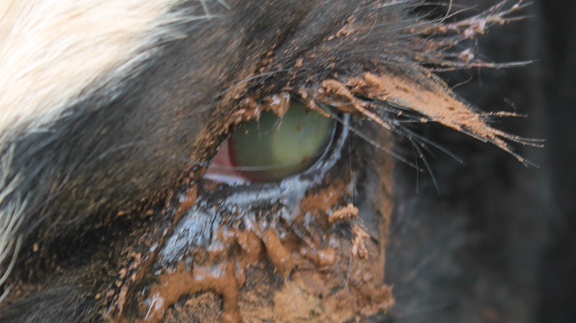Farm & Ranch
Infectious Bovine Keratoconjunctivitis (IBK)—Pink eye

By Jessica Crabtree with Dr. Jered Harlan
Aside from foot rot, infectious bovine keratoconjunctivitis, pink eye, is the next prevalent problem in cattle. Younger cattle seem to be more susceptible because older cattle have built protective antibodies on the eye surface as a result of previous exposure. Grazing cattle to dairy cattle can fall victim to the primary infectious agent of pink eye, a bacterium called Moraxella bovis. Although highly contagious and painful, pink eye is not fatal, but costs producers a great deal of money each year through deceased weight gain, decreased milk supply and treatment costs.
The bacterial disease causes infection and ulceration of the cornea and inflammation of the eye and skin surfaces lining the eye. If not properly treated, pink eye can result in permanent corneal scar and eyeball rupture leading to blindness. Research has shown that Moraxella bovis attaches to the cornea with hair-like protein extensions called pili. Toxins produced by this organism are believed to damage the cornea, leading to a cornea ulcer that looks like a hole or depression in the cornea.
Most common in the summer and fall, pink eye’s initial symptoms include swelling and redness of the conjunctiva, excessive tearing and squinting. Symptoms lead to decreased appetite due to pain and elevated body temperature. Within days a small opaque area will appear in the center of the cornea. By day six the entire cornea will be gray-white to yellow with deep central ulceration of the cornea. Recovery takes three to five weeks. In severe situations, ulceration and corneal rupture with loss of eye contents, cone-shaped bulging of the eye and blindness have occurred.
To read more pick up the April 2015 issue of North Texas Farm & Ranch.
Farm & Ranch
Acorn Toxicity

By Barry Whitworth, DVM, MPH
With the prolonged drought, most pastures in Oklahoma end up in poor condition. With the lack of available forage, animals may go in search of alternative foods.
If oak trees are in the pastures, acorns may be a favorite meal for some livestock in the fall. This may result in oak poisoning.
Oak leaves, twigs, buds, and acorns may be toxic to some animals when consumed.
To read more, pick up a copy of the November edition of North Texas Farm & Ranch magazine, available digitally and in print. To subscribe by mail, call 940-872-5922.

Farm & Ranch
Silver Bluestems

By: Tony Dean
There are a handful of grasses on North Texas grazing lands ranchers need to know, not because they are highly desirable, but rather because they are not of much value. I call them “decom” plants, which is am acronym for “Don’t Ever Count On Me.” Silver bluestem is a “decom” grass.
Silver bluestem is a perennial which grows in all areas of Texas. It can survive in almost all soil types, and in full sun conditions or in semi shade. It grows up to three feet tall and is easily recognized with the presence of the white fuzzy seed head. Also, one of the identifying characteristics of Silver bluestem is a bend in the stems at each node, causing the plants to take on a rounded shape as they mature.
To read more, pick up a copy of the November edition of North Texas Farm & Ranch magazine, available digitally and in print. To subscribe by mail, call 940-872-5922.

Farm & Ranch
Meanwhile Back At The Ranch

By: Rayford Pullen
Fall is here which means winter is closing in on us and before we officially get into winter, we need to make sure our factories are either producing or will be producing in a few months.
We have been pregnancy testing our cows this fall and if they are not bred or nursing a calf, we are bidding them adios. With annual costs somewhere between $900.00 and $1,000.00 per cow, those cows not producing a live weaned calf are costing us quite a bit.
To read more, pick up a copy of the November edition of North Texas Farm & Ranch magazine, available digitally and in print. To subscribe by mail, call 940-872-5922.
-

 Country Lifestyles2 years ago
Country Lifestyles2 years agoScott & Stacey Schumacher: A Growth Mindset
-

 Country Lifestyles8 years ago
Country Lifestyles8 years agoStyle Your Profile – What your style cowboy hat says about you and new trends in 2017
-

 HOME8 years ago
HOME8 years agoGrazing North Texas – Wilman Lovegrass
-

 Equine1 year ago
Equine1 year agoThe Will to Win
-

 Country Lifestyles5 years ago
Country Lifestyles5 years agoAmber Crawford, Breakaway Roper
-

 Outdoor9 years ago
Outdoor9 years agoButtercup or Primrose?
-

 Country Lifestyles8 years ago
Country Lifestyles8 years agoJune 2016 Profile – The man behind the mic: Bob Tallman
-

 Country Lifestyles8 years ago
Country Lifestyles8 years agoDecember 2016 Profile, Rusty Riddle – The Riddle Way




